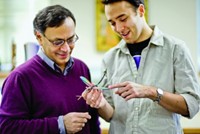Advertisement
Grab your lab coat. Let's get started
Welcome!
Welcome!
Create an account below to get 6 C&EN articles per month, receive newsletters and more - all free.
It seems this is your first time logging in online. Please enter the following information to continue.
As an ACS member you automatically get access to this site. All we need is few more details to create your reading experience.
Not you? Sign in with a different account.
Not you? Sign in with a different account.
ERROR 1
ERROR 1
ERROR 2
ERROR 2
ERROR 2
ERROR 2
ERROR 2
Password and Confirm password must match.
If you have an ACS member number, please enter it here so we can link this account to your membership. (optional)
ERROR 2
ACS values your privacy. By submitting your information, you are gaining access to C&EN and subscribing to our weekly newsletter. We use the information you provide to make your reading experience better, and we will never sell your data to third party members.
Policy
Academic R&D Spending Trends
Chemical research sector grew 7.3% in 2004, slightly less than the average for science as a whole
by Sophie L. Rovner
December 18, 2006
| A version of this story appeared in
Volume 84, Issue 51

Fiscal 2004 was another very good year in terms of investment in research and development in the academic science and engineering sector. Total academic R&D spending climbed 7.2% to $42.9 billion that year, the most recent for which data are available from the National Science Foundation.
Although it is generous, that expansion pales beside the 10.1% growth of 2003 and 10.9% of 2002. In fact, 2004's increase was the smallest since 1999. The expansion was also smaller than the 7.4% average annual increase in total R&D spending from 1994 to 2004.
When inflation is taken into account, total R&D spending by universities and colleges rose 4.7% in terms of constant dollars between 2003 and 2004. Between 1994 and 2004, spending grew a total of 69.3% in constant dollars, compared with 104.2% in current dollars.
The federal government is by far the largest source of funds used in academe for R&D. In terms of current dollars, it boosted its investment by 10.6% in 2004 to $27.4 billion. As a result, the federal government's share of the total expanded for the fourth year in a row to reach 63.8% in 2004. Institutions' share of funding slipped for the third year in a row to 18.1%. State and local governments chipped in 6.6% of the total in 2004—the same contribution as the prior year—while industry's share dropped for the fifth year in a row to 4.9%.
Each year, about three-quarters of the total academic research budget is funneled into basic R&D. The sector saw a 7.8% increase in funding to $32.3 billion in 2004, an expansion somewhat smaller than the 8.7% annual average for the previous decade. Applied R&D investment rose 5.4% in 2004, besting the 10-year annual average of 4.2%.
Science consumed $36.6 billion, or 85.3% of the total research budget in 2004, for a 7.5% rise over 2003. The share of total R&D spending devoted to the life sciences continued its slow but steady expansion, reaching 59.7% that year. The $25.7 billion invested in the field represented an 8.0% upsurge over the prior year.
Funding for the physical sciences rose 8.2% to $3.5 billion in 2004, bringing the sector's share of total R&D spending to 8.3%. Outlays for chemistry, which represented 3.1% of the total R&D budget, increased 7.3% to $1.3 billion.
On a constant-dollar basis, chemistry spending rose 4.8% from 2003 to 2004. Between 1994 and 2004, the outlay for chemical R&D grew a total of 43.6% in constant dollars and 73.3% in current dollars.
Engineering absorbed $6.3 billion, or 14.7% of the overall R&D budget in 2004, an increase of 5.3% over 2003 in terms of current dollars. Chemical engineering, which accounted for a mere 1.1% of total R&D spending, enjoyed an 8.8% rise to $493 million in 2004. Some 1.3% of the total R&D budget was invested in materials engineering, which saw a 3.1% increase to $565 million.
Federal support for materials engineering shot up 12.1% to $352 million in 2004. Federal backing for chemical engineering reached $268 million, a boost of 8.1% compared with 2003. Investment in engineering as a whole rose by the same percentage to $3.9 billion. Science did even better, with a generous 11.1% rise to $23.5 billion. Within the sector, the government particularly favored chemistry, raising its allotment 12.1% to $919 million in 2004. That increase was more than double the annual average over the prior decade. The federal government also boosted spending on the life sciences by 12.1%, bringing its contribution to $16.4 billion in 2004.
Which institutions spent the most on chemical R&D in 2004? For the third year in a row, the University of California, San Francisco, headed the list. The school poured $29.6 million into the sector, 2.8% more than the prior year. UC Berkeley, with an outlay of $26.0 million, and the University of Texas, Austin, which spent $24.2 million, once again placed second and third, respectively. Fourth place went to California Institute of Technology with a $23.0 million expenditure. And Pennsylvania State University came in fifth with a $22.3 million outlay.
Altogether, the 10 schools that invested most in chemical R&D in 2004 increased their expenditures by 7.5% versus 2003, slightly beating the 7.3% average annual increase of the prior 10 years.
Although the order of the top 10 spenders changed a fair bit between 2003 and 2004, the composition of the list changed very little. Caltech was the only newcomer on the list. It displaced Texas A&M University, which placed seventh in 2003 but dropped down to 12th place the following year.
In terms of federal support for chemical R&D, UC San Francisco again pulled in the most dollars in 2004. But the federal government's $22.2 million contribution to the school was 2.5% less than in 2003. UC Berkeley, Caltech, Harvard University, and Massachusetts Institute of Technology rounded out the top five.
Purdue University spent the most on chemical engineering research in 2004, investing some $22.4 million, though this number includes an outlay of $17.2 million for a chemical engineering research facility. Texas A&M, which spent $16.6 million on chemical engineering R&D, placed second. MIT came in third with a $15.1 million outlay. Penn State's $14.1 million and North Carolina State University's $13.3 million rounded out the top five.
Purdue and Princeton University were new to the top 10 list of spenders in 2004, displacing Stanford University and the University of Delaware.
The federal government's largest outlay for chemical engineering R&D went to MIT. The university's $9.1 million share was 15.0% smaller than its 2003 allotment, however. Johns Hopkins University came in second, followed by Penn State, Georgia Institute of Technology, and Stanford.
Altogether, colleges and universities reduced their spending on chemical research equipment by 1.9% in 2004 compared with the previous year, bringing their total outlay down to $116.6 million. Even the top 25 biggest spenders in 2004 barely managed to keep up with their 2003 expenditures. Caltech, which came in first, dropped its spending 9.4% to $3.7 million. Second-place UC San Francisco cut back by 28.9% to $2.5 million. Although third-place UC Berkeley raised its outlay 29.9%, spending declined at both MIT and UC Los Angeles, which came in fourth and fifth, respectively.
Federal support for chemical research equipment can vary greatly from year to year. In 2004, it edged up just 0.1% to $77.5 million for colleges and universities as a group. At the top 25 institutions, however, government backing jumped 16.6% to $30.9 million. MIT; the University of Washington, Seattle; Harvard; UC San Francisco; and the University of Wisconsin, Madison, received the largest federal grants for chemical research equipment.
The number of students seeking graduate degrees in chemistry rose 3.6% to 20,776 in 2004, well above the 10-year average annual increase of just 0.5%. The number of those seeking chemical engineering graduate degrees slipped 0.9% to 7,452. Nearly half of the chemical engineering grad students were foreign, as were more than one-third of the chemistry students.
The number of postdoctoral appointments in chemistry edged up 1.9% to 4,108 in 2004, while those in chemical engineering rose 2.4% to 688.
Data for this article were drawn primarily from NSF's WebCASPAR database of academic science and engineering statistics, which can be reached online at caspar.nsf.gov. Further statistical information came from the annual Academic Research & Development Expenditures report managed by John E. Jankowski of NSF's Division of Science Resources Statistics. This report and other data can be viewed at nsf.gov/sbe/srs/rdexp/start.htm.
Note that numbers from different tables may not match because of rounding.
Read More
Download Academic R&D Spending Trends
- *This document has been saved as an Adobe Acrobat PDF file to retain the original formatting of the hard copy version. To view the document you will need Adobe Acrobat Reader.
- This file includes the following tables:
- FIELDS OF ACADEMIC R&D SPENDING
- Average annual growth in spending for chemistry has been outpaced by that for life sciences since 1994
- FEDERALLY FINANCED R&D SPENDING AT UNIVERSITIES
- Despite spurt in 2004, growth in funds for chemistry lagged other sciences during the past 10-year period
- SCHOOLS SPENDING MOST ON CHEMICAL R&D
- University of California???s San Francisco and Berkeley campuses and University of Texas, Austin, held on to the top three spots in 2004
- SCHOOLS WITH MOST FEDERAL SUPPORT FOR CHEMICAL R&D
- Top 50 schools' growth in 2004 funding significantly outpaced the 10-year annual average rate
- TOP 25 UNIVERSITIES IN 2004 R&D SPENDING
- Accounted for 30% of spending in chemistry and 37% of spending in physical sciences
- CHARACTER OF ACADEMIC R&D SPENDING
- R&D budget share devoted to basic research inched up in 2004
- FEDERAL SUPPORT FOR CHEMICAL ENGINEERING R&D
- Georgia Institute of Technology and Princeton University led growth in the top 10 in 2004
- FEDERAL SUPPORT FOR CHEMICAL RESEARCH EQUIPMENT
- Growth at the top 25 far outpaced that of total support in 2004, continuing a long-term trend
- SOURCES OF ACADEMIC R&D FUNDS
- At 64% in 2004, federal share was highest it has been since 1985
- TOP 25 UNIVERSITIES IN 2004 R&D SPENDING
- Accounted for 30% of spending in chemistry and 37% of spending in physical sciences
- SCHOOLS SPENDING MOST ON CHEMICAL RESEARCH EQUIPMENT
- Total spending dipped again in 2004, although a few schools saw whopping increases
- UNIVERSITY SPENDING FOR RESEARCH EQUIPMENT
- Two-thirds of the funding for chemistry equipment was provided by the federal government in 2004
- SCHOOLS SPENDING MOST ON CHEMICAL ENGINEERING R&D
- Purdue University bounded to the top of the list in 2004
- FOREIGN GRADUATE STUDENTS
- More than one-third of chemistry and nearly half of chemical engineering grad students are from outside the U.S.
- SCIENCE GRADUATE STUDENTS
- Number studying chemistry inched up again in 2004, besting the level of a decade earlier
- POSTDOCTORAL POSITIONS
- Number of postdocs in chemistry has risen very slightly since 1994





Join the conversation
Contact the reporter
Submit a Letter to the Editor for publication
Engage with us on Twitter